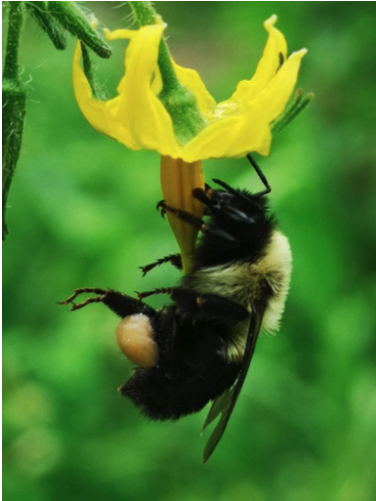What’s That Sound? Buzz Pollination!
go.ncsu.edu/readext?1010687
en Español / em Português
El inglés es el idioma de control de esta página. En la medida en que haya algún conflicto entre la traducción al inglés y la traducción, el inglés prevalece.
Al hacer clic en el enlace de traducción se activa un servicio de traducción gratuito para convertir la página al español. Al igual que con cualquier traducción por Internet, la conversión no es sensible al contexto y puede que no traduzca el texto en su significado original. NC State Extension no garantiza la exactitud del texto traducido. Por favor, tenga en cuenta que algunas aplicaciones y/o servicios pueden no funcionar como se espera cuando se traducen.
Português
Inglês é o idioma de controle desta página. Na medida que haja algum conflito entre o texto original em Inglês e a tradução, o Inglês prevalece.
Ao clicar no link de tradução, um serviço gratuito de tradução será ativado para converter a página para o Português. Como em qualquer tradução pela internet, a conversão não é sensivel ao contexto e pode não ocorrer a tradução para o significado orginal. O serviço de Extensão da Carolina do Norte (NC State Extension) não garante a exatidão do texto traduzido. Por favor, observe que algumas funções ou serviços podem não funcionar como esperado após a tradução.
English
English is the controlling language of this page. To the extent there is any conflict between the English text and the translation, English controls.
Clicking on the translation link activates a free translation service to convert the page to Spanish. As with any Internet translation, the conversion is not context-sensitive and may not translate the text to its original meaning. NC State Extension does not guarantee the accuracy of the translated text. Please note that some applications and/or services may not function as expected when translated.
Collapse ▲Plant-pollinator interactions are very complex and nearly 75% of flowering plants rely on animals to move pollen to flowers. The color, shape, and smell of flowers partly determine the types of pollinators that visit them. It’s all in the details – in some plants, like those related to the tomato family, there’s a special surprise maneuver to get the pollination job accomplished.
It’s an unusual “anther rupture” trick where the part of a flower that contains the pollen (anther) sheds it through pores at their tips. This process is often associated with buzz pollination by insects, such as bees and bumblebees, which can vibrate their bodies at the required frequency (240–405 Hz) to release the pollen. It is similar to the musical note of “B”. No pun intended and my apologies to fellow Beatle fans out there, but it’s a case of “Shake it up baby…”
This unusual type of anther is called a “poricidal anther” and can help prevent excessive pollen loss by only rewarding pollinators that specialize in buzz pollination. Plants with poricidal anthers often produce little to no nectar, but their pollen is rich in protein – essential to produce strong colonies for honey production, boost bee colonies, bee queen breeding, and more.
And the dance moves! This pollen removal boogie requires bees that land on the flowers, curl around the “anther cone” , and vibrate their indirect flight muscles at high frequency in contact with anthers and thereby induce rapid pollen release. This produces an audible buzzing sound and is a unique form of pollination termed “buzz pollination”.
Buzzing bees are usually active in early morning because anther pollen release of most buzz flowers occurs during this period. The total time of vibration of anthers of a given flower by a buzzing bee is termed the handling time of the bee, and it varies by bee species – some prefer the tempo of a Tango, others the Texas-Two-Step.
Researchers have observed bees selectively visiting more younger pollen-rich flowers than older flowers, spending more time on younger flowers. It’s a supply and demand thing. For example, while the relatives of the tomato (Solanaceae family) lack nectar and restrict access to pollen, they are heavily visited by a large number of bees, so they are very popular. The release of large amounts of pollen during initial vibrations of new flowers decreases the amount of pollen left with older flowers. Like empty store shelves after a Black Friday shopping day.
Timing is everything for another reason as well. The flower part (stigma) that accepts the pollen becomes receptive a day before the flower blooms, but with its own pollen not beginning to shed until later, so cross pollination is favored over self pollination. The stigma remains receptive and the pollen continues to spread as long as the flower is open, depending on weather and other conditions this can vary from a day to a week. Another fun fact about plants to help you “Know Before You Grow”. Isn’t nature fascinating?





